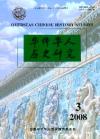
Nagura Kyoko奈仓京子
in Journal of Overseas Chinese History Studies (华侨华人历史研究) 2008 Vol 3
Reviewed by Severin Kuok (PhD candidate, Center for Chinese and East Asian Studies, School of Language, Literature and Culture Studies, Jawaharlal Nehru University, New Delhi, India)
There is a plethora of literature on Chinese migration and overseas Chinese, but the study of overseas ‘returnee farms’ still remains a fairly unexplored subject. Overseas Chinese returnee farms were settlements established by the Chinese government between the 1950s and 1970s. They were used to accommodate the large numbers of ethnic Chinese who were forced out of their host countries in Southeast Asia where they had migrated many generations ago. Most of these ‘returnees’ had been born in their host countries and thus were not returnees in the true sense of the word. Kyoko Nagura is the author of three books, all of which talk about Chinese migrants and their experiences on returning to their homeland, highlighting the complexities of these negotiations. In her study of the adaptation methodologies, experiences, and outcomes of overseas Chinese who return to China from their host countries, Nagura uses the Overseas Chinese farms as research targets, and in this article she has used the Yuehaiwan Overseas Chinese farm in Guangdong Province as a field site.
In this article the author focuses on the unique identities that are formed within this seemingly ‘homogenous’ community through the interactions among various groups (overseas Chinese returnees from different Southeast Asian counties) and with outsiders (which in this case are the locals), using the concept of a ‘multi-layer’ community. She claims that these different groups within the overseas farms have to negotiate not only with the local governments and select their ways of entering the local society according to their own specific characteristics, but also need to work out their competing political rights and economic benefits. All these factors lead to the multi-layering of this community in terms of lifestyles, traditions and culture, inter-group relations etc. The article’s fundamental argument is that such an understanding of this ‘multi-layered’ community challenges the superficial bipolar relationship structure between returnees and locals and this strongly influences the process of identity formation among the returnees.
The three main sections of this article include descriptions of the factors in the formation of a multi-layered community, the formation of a returnee culture and identity, and the dynamics of the returnee identity. The author specifically focuses on comparing the contrasts between the predominant Indonesian and Vietnamese returnee communities in this Overseas Chinese farm. The first section provides a clear map of this farm in terms of geographical structure, population and other demographic characteristics. It tells us that the Indonesian returnees constitute the dominant group in this farm in terms of population and economic strength with the Vietnamese being next in the hierarchy. It provides us details about the contrasted differences between these two dominant groups in terms of their political and social status, economic development, economic background and professional achievements and how these factors influence the creation of this multi-layered community (which also include returnees from other countries such as Thailand, Malaysia, Singapore, Myanmar, Philippines, and India).
The second section talks about the different dynamics in the formation of a returnee culture and identity in the Indonesian and Vietnamese groups at the Yuehaiwan Overseas Returnee Farm. There is a stark difference in the levels of assimilation and adaption to local environs between these two groups of people. Some of these differences exist due to the background and habits that each group brings from its host county, but other contrasts arise as they live, assimilate, and grasp opportunities for development within China. Dissimilarities notwithstanding, there is also a great degree of mutual interaction and acceptance between these two communities in the farm as they actively participate in each other’s cultural and religious activities.
In the third section, the author elucidates how stronger economic stature helps and boosts setting up of international social networks. She uses the example of the Indonesian community in this farm to explain how the community has better grasped educational and employment opportunities to improve their economic status and build stronger social networks. These networks not only include other Indonesian returnees in China, but also Chinese Indonesians and Chinese Indonesians who have migrated to a third country. The interactions with these different groups of Chinese Indonesians have also strongly influenced the ‘multi-layered’ sense of identity within the Indonesian returnees, though the bond with the farm and China remains strong. In contrast, the Vietnamese returnees do not exhibit such strong social networks. Due to weaker economic status in China, the Vietnamese returnees are constantly striving to re-migrate to other developed countries in the world and their ties with China and the returnee farm only remain as long as they have kin still residing there.
This article, with its perspective of a multi-layered community, provides an expanded understanding of the origins and development of overseas returnee farms, the formation of a complex triple hyphenated identity of its residents and their negotiations within and without the framework of overseas returnee farms. However, it fails to address the socio-cultural exclusion and ‘otherness’ that these returnees face in their interactions with each other and local residents. Although there is mention of the locals and domestic migrant labor interactions with these returnee communities, the study does not delve deeper into their arenas of contact and the possible friction that may arise. It also does not explain if the reasons for the ‘return’ of the returnee communities in any way affect the construct of their identity in China. Further, the difference in the level of cultural assimilation that takes place between different generations of returnees within the same community and how this helps unpack the question of identity formation has not been discussed. Despite these gaps in the study, this article fills a void in scholarship on return migration, refugee migration and returnee farms of China.
